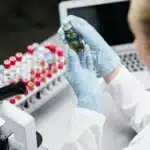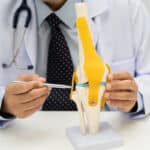
Most have their progesterone level low in the menstrual cycle. In this cycle, ovulation and the luteal phase start, and the progesterone levels start to prepare the body for the upcoming pregnancy. There could be some potential reasons for low-level progesterone and that is the time when symptoms start to occur. If this hormone level has deficiencies – you would rather go for hormone replacement therapy.
Causes of Progesterone Deficiency
As progesterone is naturally produced in the body in the ovulation process, the most prominent cause of low progesterone is anovulation or other serious problems with the productive organs. There are other symptoms alongside –
PCOS
PCOS or polycystic ovary syndrome makes the body produce excessive androgen hormones that can result in irregular periods, cysts in ovaries, and hirsutism. This is the most common cause of anovulation.
Thyroid
The thyroid glands in our body produce T3 and T4 and these hormones help to regulate the endocrine system. Hypothyroidism can affect progesterone levels as it decreases the functions of the ovaries or increases the prolactin level.
Chronic Stress
High cortisol levels can result in hypothalamic amenorrhea – this is a condition where the body goes through a lack of menstruation and ovulation. There could be different causes for chronic stress in individuals. An excessively intense workout can make the body stressed out and stop your menstruation.
Lack of Fat
A female body needs at least 12% body fat to perform all hormonal functions properly. For women who exercise vigorously and have dropped body fat ratio, eating disorders, or other medical issues, it may stop menstruation and ovulation.
Obesity
Obese or overweight women can experience suppressed progesterone production. Obesity along with low progesterone is connected with endometrial cancer.
Symptoms of Progesterone Deficiency
Irregular Menstruation Cycle
Long menstrual cycles, irregular cycles, or short luteal phase (if the ovulation period is less than 10 days), PCOS, cramps in the cycle, and mid-cycle spotting – are the signs of progesterone deficiency.
Infertility
To achieve a healthy pregnancy, the female body needs the right amount of progesterone. If you are having issues conceiving or have a miscarriage – you would better check the progesterone level.
Acne, Cracked Nails, Dry Skin
If you have acne in your matured skin, brittle nails, flaky and cracked skin, dry skin, peeling of your skin, heels, and hands – you could have a low level of progesterone.
Depression, Anxiety, Mood swings
Many women think estrogen is responsible for mood swings. But after 30, most women get dropped progesterone level. This is the primary reason for mood swings as it helps in keeping the mind calm.
Low Libido and Fatigue
After giving birth, most women complain about low libido and fatigue. However, many women in their 30s and 40s irrespective of childbearing status experience progesterone drop followed by a lack of sex drive and energy.
Lack of metabolism, Abdominal Weight Gain, and Sugar Craving
Though people blame sugar and insulin for metabolic dysfunction, and it could be low progesterone levels as we age.
For hormone replacement therapy in OKC, contact Oklahoma Spine & Pain Management.
**Disclaimer: This content should not be considered medical advice and does not imply a doctor-patient relationship.






